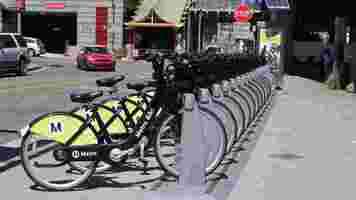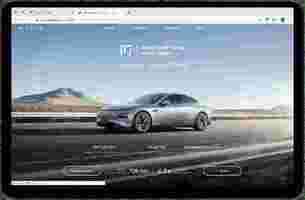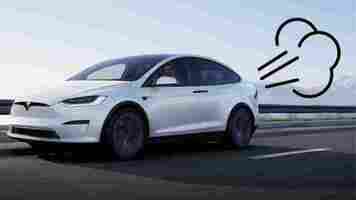Nice, LA residents are cycling 22% more than they did in 2017
This article was originally published by Christopher Carey on Cities Today , the leading news platform on urban mobility and innovation, reaching an international audience of city leaders. For the latest updates follow Cities Today on Twitter , Facebook , LinkedIn , Instagram , and YouTube , or sign up for Cities Today News.

The Los Angeles Department of Transportation (LADOT) has published the findings of a study on active travel in the city, with data revealing a 22 percent increase in cycling compared to 2017.
The count, which took place over several weekends in 2019, showed there was a significant upturn in the number of people walking and cycling in places where LADOT had implemented safety and complete street improvements.
It also showed that while women make up only 16 percent of people biking, there was a 120 percent increase in female riders on streets with dedicated bike paths.
“What gets measured matters,” said LADOT General Manager Seleta Reynolds. “Thanks to this report, LADOT gained valuable insights into how people move through Los Angeles neighborhoods so that our investments can deliver the most effective improvements for people walking and biking.”
Demographics and data
The report also examined how transportation investments can create streets that feel safe and comfortable for people of all ages and abilities, and the data will be used to guide future pedestrian and bike infrastructure projects throughout the city.
Key findings included that forty percent of people walking were female. This increases to 44 percent on weekends.
The count showed a 73 percent increase in cycling ridership on Figueroa Street in downtown LA since the installation of the MyFigueroa streetscape project, compared to counts that took place in 2017.
The survey was one of the first large-scale tests of the Southern California Association of Governments’ recently launched Active Transportation Database , which provides ways for agencies to collect and store data for public use.
Data from the report will also be available on city websites such as NavigateLA and Los Angeles Open Data .
The transit agency’s next bike and walk count is scheduled for autumn 2021 and is expected to increase to 100 locations throughout the city.
LADOT will also track usage before and after transportation projects and programs are implemented.
Do EVs excite your electrons? Do ebikes get your wheels spinning? Do self-driving cars get you all charged up?
Then you need the weekly SHIFT newsletter in your life. Click here to sign up .
First Xpengs land in Norway as the Chinese EV maker prepares for European expansion
Chinese EV maker, Xpeng, has delivered the first batch of its new vehicle to customers in Europe.

One hundred drivers in Norway received their new G3s, Xpeng‘s all-electric SUV, recently, Bloomberg reports .
In an interview with the news outlet, company president and chairman Brian Gu said Xpeng is going to spend the next 12 months laying the groundwork for sales in its next European country.
The EV maker is not saying anything for definite about where it will go next, though.
However, given that it’s launched in Norway, Europe’s leading EV market, it wouldn’t be surprising if it went after other European nations where EVs are already quite popular — think Netherlands, Iceland, Sweden, and Denmark.
Xpeng does recognize that if it’s going to become a successful EV company, it needs to operate on a global scale. So far, its vehicles have only been offered to its domestic market.
The Guangzhou-based EV maker has worked with a local distributor to bring its vehicles to Norway. It’s a model that it may use in other European nations, so unlike other EV companies it may sell through a third-party rather than direct.


SHIFT has contacted Xpeng and its Norwegian distributor for comment, we’ll update this piece as we hear more.
You might not have heard of Xpeng before, if you live outside of China you probably haven’t. But it’s one of a crop of Chinese electric carmakers, like NIO and BYD, that are expanding beyond their own shores and are gaining interest around the world.
The most alluring thing about Chinese EVs is their relatively low cost to buy, compared to other EV brands.
The Xpeng P7 costs about $6,000 less thank its Tesla Model 3 rival. While things like long term durability and build quality are yet to reveal themselves, the low entry cost could be enough to get a whole load more people interested in electric motoring.
SHIFT is brought to you by Polestar. It’s time to accelerate the shift to sustainable mobility. That is why Polestar combines electric driving with cutting-edge design and thrilling performance. Find out how .
Boo! Tesla’s recalling a feature that made its horn sound like a fart
A mere week after it was forced to slash the FSD’s rolling stop function , Tesla is recalling yet another feature of its vehicles.

This time, it’s something called Boombox that caught the eye of t he National Highway Traffic Safety Administration (NHTSA).
What’s wrong with Boombox, you ask? I’ll allow this tweet to explain:
Because, hell, who in their right minds would want their car to make a boring ol’ horn sound? That’s totally passé. Especially if your vehicle can sound like a goat, a lion, or a FART. Or, indeed, any other type of audio you’d like.
The thing is, EV horn honks serve a more important purpose than the occasional flex or joke that Boombox enables.
Let’s keep in mind that electric vehicles are quiet, for which reason they’re required to e mit some sort of sound at low speeds so pedestrians can hear them .
According to the NHTSA’s filing, the Boombox function “may obscure the Pedestrian Warning System (PWS) sounds.” And, potentially, distract pedestrians as well.
Let’s be honest: a goat bleat would d efinitely muddle an EV’s warning noise . And yes, if I heard a loud fart while crossing a street, I’m more likely to stop and find where it’s coming from instead of getting the fuck out of the way.
And, as federal regulations prohibit manufacturers from “altering or modifying the sound-emitting capability of the Pedestrian Warning System,” Tesla has once again succumbed to the NHTSA’s demands.
As a result, the EV maker will have to recall the feature in 578,607 Teslas through an over-the-air update.
Genuinely? I’m bummed. Now I’ll never know the joy of walking down a street filled with Teslas making farmyard sounds. Yes, my life is a bit safer, but at what cost?